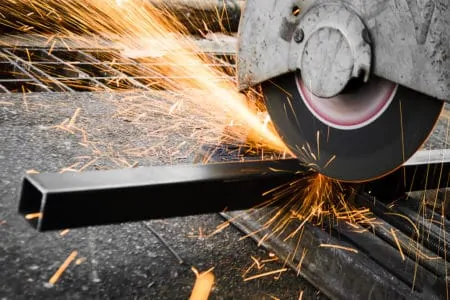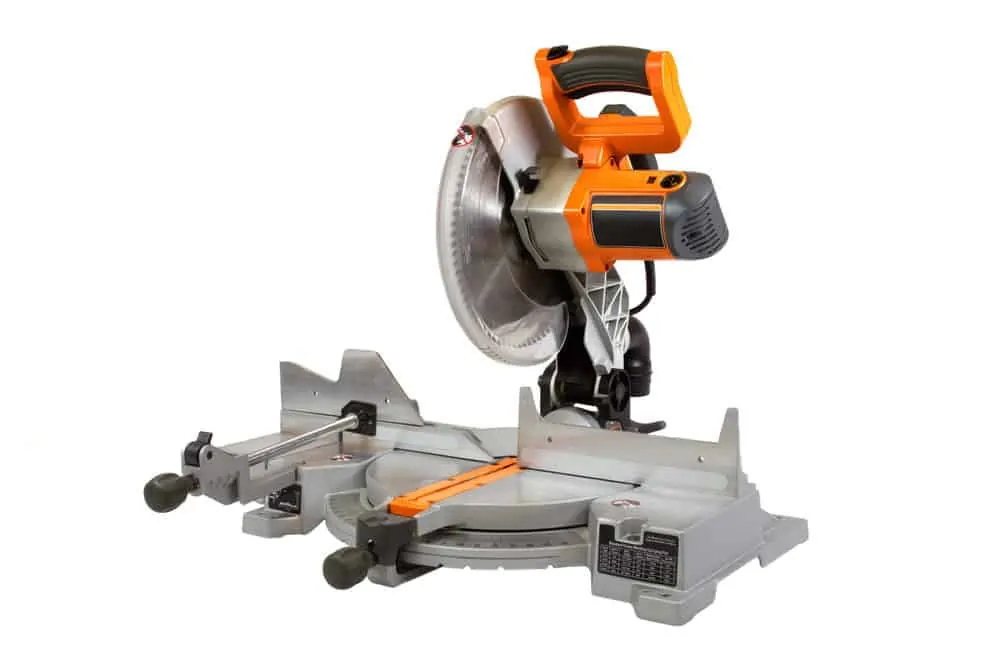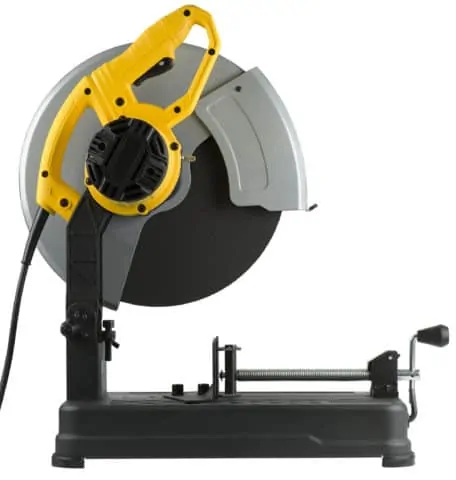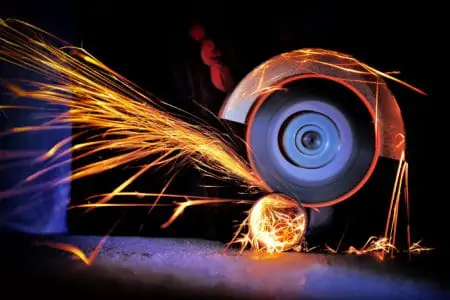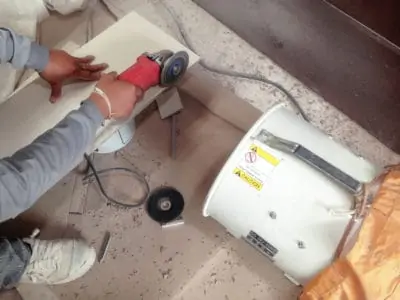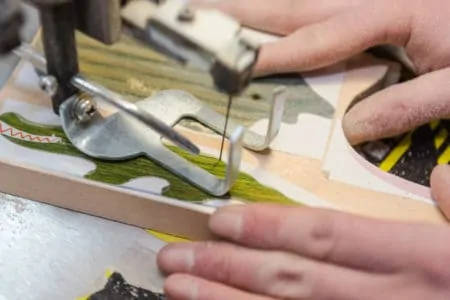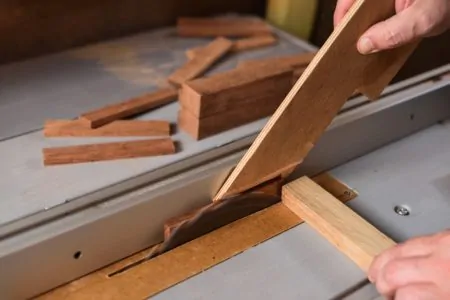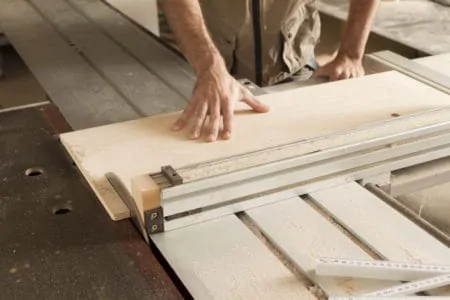At a glance, chop saws and miter saws look almost identical. Both have a spinning circular blade mounted on a pivoting arm. They are tabletop saws and will both cut straight lines.
However, chop saws and miter saws function differently and are designed for different tasks. If you intend to buy one, it is important to know the differences between the two types to ensure it is suitable.
In this article, we will explain what chop saws and miter saws are and why they might be right or wrong for you. This should help you choose a saw that will be suitable for whichever task you are working on.
Key Takeaways
- Chop saws cut 90-degree angles and handle harder materials, while miter saws make angled, beveled, and compound cuts.
- Miter saws are ideal for detail work in moldings and frames, and chop saws excel in cutting metal, masonry, and composites.
- Chop saws can’t cut angles, only 90-degree crosscuts, whereas miter saws provide more versatility in cutting angles.
- Miter saws can’t replace chop saws for cutting harder materials due to their slower spinning blades and lower power.
What Is a Miter Saw?
A miter saw is a vertical, spinning circular blade mounted on a pivoting arm. It can swivel to cut angles, and the miter saw blade can swing to the left or the right to cut miters, bevels, and compound cuts.
Miter saws are smaller than chop saws. Their blades range in size from 8 to 12 inches.
Some miter saws are dual bevel, meaning they can swing either way, so there is no need to turn over the material you are working on to cut in the other direction.
What Is a Miter Saw Used For?
Miter saws make complex cuts at set angles. As such, they are frequently used for detail work in base and crown moldings, in addition to window and door frames. As you can cut multiple pieces of wood at specific angles with ease, you will be able to achieve a professional finish when the sections are placed together.
Next time you look at the door frames in your home, you can be relatively confident that a miter saw cut their angles. If you have wooden doors, their bevels were likely also cut using a miter saw.
A miter saw is a staple tool of carpenters and is used to achieve a neat finish and create intricate details.
Pros
- Precise
- Makes bevel, miter, and compound cuts
- Portable
- Relatively safe to use
- Excellent for finer detail work
Cons
- Limited space to work in
- Won’t cut metal or masonry
What is a Chop Saw?
A chop saw has an abrasive spinning disc mounted on a pivoting arm. The disc has no teeth; instead, an abrasive diamond coating cuts through the material. A chop saw can make short work of even the toughest materials.
In addition to their different blades, chop saws differ from miter saws in terms of versatility. Unlike miter saws, they cannot pivot left or right, so they are limited to only cutting at 90-degree angles.
Chop saws are larger than miter saws and are used for jobs where brute force is required. A typical blade is a minimum of 14 inches. When cutting with a chop saw, some materials will produce a lot of sparks, so it is essential that there are no combustible or flammable items nearby.
What Is a Chop Saw Used For?
Chop saws make short work of metal, masonry, wood, and composite materials. They can even cut through lumber with embedded nails. Construction workers trust this tool because, although it is very powerful, it also makes precise cuts thanks to its toothless cutting disc.
You can buy different blades for your chop saw, but be careful if you insert a toothed variety. Chop saw blades spin at around 5,000 RPM, significantly quicker than miter saws. If you try to use a toothed blade to cut wood with your chop saw, you risk dangerous kickback and potentially severe injury.
A chop saw is one of the foundations of any productive construction site and plays a major part in building homes from the ground up.
Can a Chop Saw Cut Angles?
A chop saw cannot cut miters and is only used to make 90-degree crosscuts. If it could cut angles, it would be called a miter saw. The only method to cut at a different angle if you have a chop saw is the old-fashioned way with a hand saw and a bevel protractor. Don’t forget a pencil or sharpie to mark where your cut will go.
Pros
- Very powerful
- Larger size
- Can cut almost any material
- Precise
Cons
- Only cuts 90-degree angles
- Lack of versatility
- Heavy
Can I Use a Miter Saw as a Chop Saw?
A miter saw operates similarly to a chop saw, so it is easy to assume that the two would be interchangeable in terms of what they can do. On the one hand, you can cut 90-degree angles with a miter saw, just like a chop saw. However, you will be limited in which materials it can cut.
A chop saw uses an abrasive blade, which rotates at a much faster speed. Miter saw blades spin at about 3,000 RPM, compared to about 5,000 RPM of chop saws. The power difference between the two is stark. A chop saw motor typically generates over 5 horsepower, twice that of a miter saw with 2.5 horsepower.
If you insert an abrasive blade into your miter saw, it will still spin and might cut effectively. However, you could also damage the saw. If you look at the blade’s housing, there is a piece of plastic that sits directly above it. If you use an abrasive disc, the friction will generate a great deal of heat and could damage this plastic component.
When an abrasive blade spins, countless tiny fragments will fly off, which appear as sparks when cutting metal. Miter saws aren’t designed for this and can become clogged, which might lead to an expensive repair.
What Can Miter and Chop Saws Cut?
| Material | Miter Saw | Chop Saw |
| Wood | Designed to cut wood. | Will cut wood, but less efficiently than a miter saw. |
| Metal | Only with an appropriate blade. | Cuts metal very effectively. |
| Plastic | Easily cuts plastic. | Will cut most plastics but a miter saw is better. |
| Composites | Cuts through composites. | Will cut composites but a miter saw is more precise. |
| Masonry | Won’t cut through masonry. | Easily slices through masonry. |
| Concrete | Cannot cut concrete. | Will cut through concrete. |
